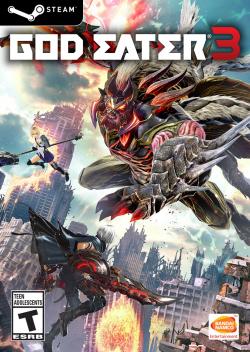 God Eater 3 (Computer)
God Eater 3 (Computer)
Official GBAtemp Review
Product Information:
- Release Date (NA): February 8, 2019
- Release Date (EU): February 8, 2019
- Release Date (JP): January 13, 2019
- Publisher: BANDAI NAMCO Studios Inc.
- Developer: BANDAI NAMCO Entertainment
- Genres: Action JRPG, large target hunter
- Also For: PlayStation 4
Game Features:
Review Approach:
A light introduction.
God Eater 3 is the third narrative installment in the God Eater franchise, though not the third game if counting remakes, remasters, or extended editions. The game is a fast-paced, acrobatic, anime-themed, action RPG wherein the player forms a jolly party to hunt a series of large beasties in a decimated, post-apocalyptic, modern setting; plucking bits and pieces from said monsters in order to craft better gear, which in turn allows the hunting of even stronger monsters. In a general sense, the God Eater games are very much similar to the Monster Hunter franchise, however God Eater has always done quite a bit to differentiate itself from the pack in a few subtle but key ways, mostly in the combat mechanics and the general speed of the game.
The world of God Eater.
The lore of the God Eater games is actually quite sprawling, spanning across an anime, a short manga, and a mobile game in addition to the 3 main entries. Considering there's so much lore behind this game, I can only give a light summary:
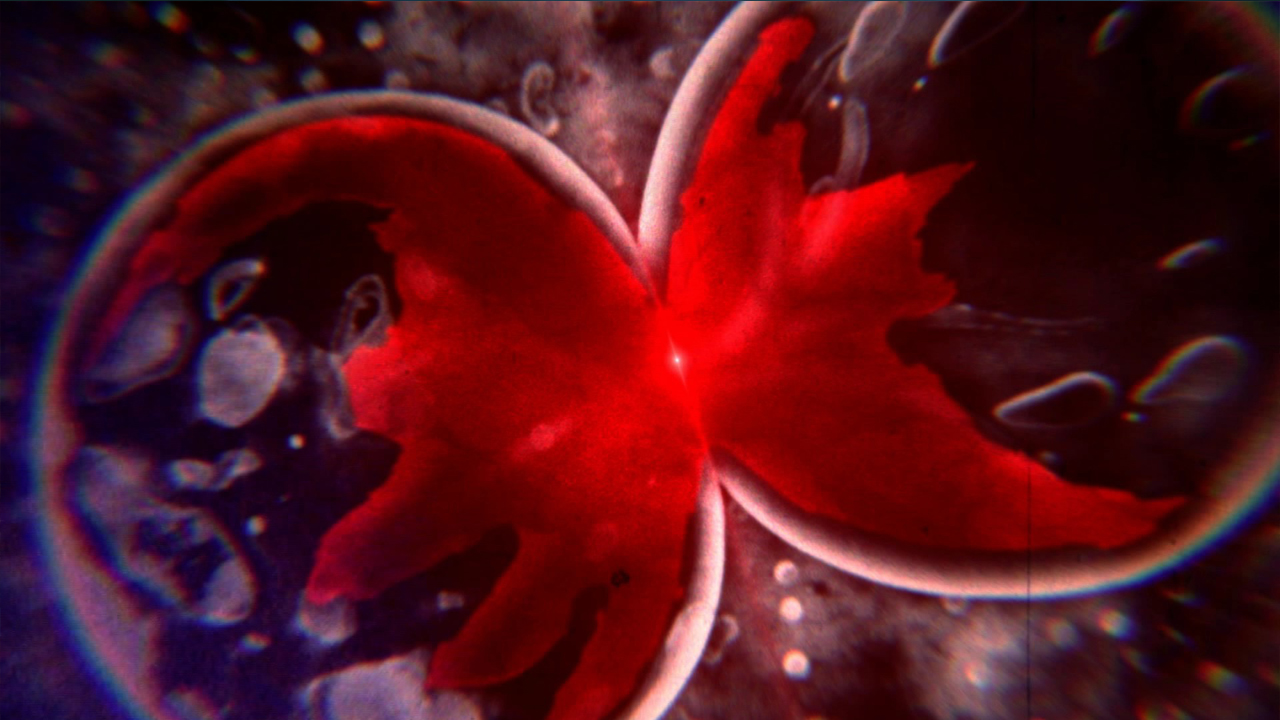
In the year 2043, a Finnish pharmaceutical conglomerate known as Fenrir inc. discovered a previously unknown, single-celled species dubbed "oracle cells". These organisms displayed extraordinary properties, being able to seemingly communicate with one another innately, as well as having the ability to deconstruct seemingly almost any form of matter they come into contact with. What's more, the organisms ended up adapting rapidly, taking on either properties of what was deconstructed, or properties which aided in the deconstruction of said materials in a sort of accelerated Darwinism. Best efforts at containment aside, eventually things unfolded into a worst-case-scenario, as 7 years later, the samples in Fenrir's labs reach a critical point in their development and formed an oracle amalgam which erupted from the facility. The cells go on a chain reaction consuming spree, eating chunks out of cars, buildings, plants, and people alike, all the while adapting and evolving at a rapid rate. Soon, the cells form "colonies" of themselves which function as a single sentient organism, the Aragami, which ravage the world and turn it into a barren wasteland of death.
Years pass, and what little was left of the Fenrir corporation's scientific staff discovered what was to be called "bias factor." This substance resists the process by which oracle cells deconstruct matter, and is the reason that the colonies of oracle cells don't end up devouring each other on contact. Adjusting the bias factor, Fenrir constructed a variant which could be compatible with human physiology, making them more resistant to the act of devouring by Aragami. Reverse engineering this same devouring process also allowed Fenrir to develop weapons which are able to both break the bonds holding the cells of an Aragami, as well as grow literal jaws to devour the Aragami itself. Equipped with these weapons and the bias factor, Fenrir began to amass soldiers of humans to fight back against the waves of ever-growing Aragami to protect what little remained of humanity called "God Eaters." Because the bias factor is a derivative of the oracle cells, without periodic injection, the oracle cells in a God Eater's body would eventually overrun and devour them from the inside, adding fairly large personal stakes to their continued service on top of the humanistic ones. The franchise puts the player in the shoes of said soldiers, and pits them against Aragami of ever growing difficulty, while using the supporting cast to play out a narrative around the protagonist.
The third entry of the franchise.
Things have changed a lot in the years since the Aragami outbreak. After the many events of God Eater 1 and 2, (not to mention all the spinoff media) a new calamity emerged in the year 2080 known as the Ashlands. This term refers to areas where microscopic organisms float through the air and devour anything they come into contact with, including Aragami. Think "oracle cells", only airborne and able to create large deathzones in which normal humans cannot survive for more than 10 minutes. To counter the ashblight, a new type of God Eater had been concocted named A.G.E.s, or Adaptive God Eaters, which can specifically survive in the clouds of ash for limited periods of time. This new variant of God Eater has allowed small, localized colonies of trade and living space called ports to be formed in areas where the ash had been cleared, allowing humanity to survive such hostile conditions. The protagonist you construct, along with their friends, Hugo, Zeke, and Kieth, are all AGEs in the indentured servitude of Pennywort, a port which treats its contracted employees more as slaves and less as humans. They're kept them in a cage, made to sleep on cots, and their bracelets are shackled together like handcuffs when not in use. Pennywort employs even children who look to be no older than 10 and conscripts them into the life of a God Eater, one of whom is implied to have his food poisoned by the guard outside. It's an utterly disgusting scenario all around, and because of this intolerable set of living conditions, Hugo and the protagonist plot their eventual escape.
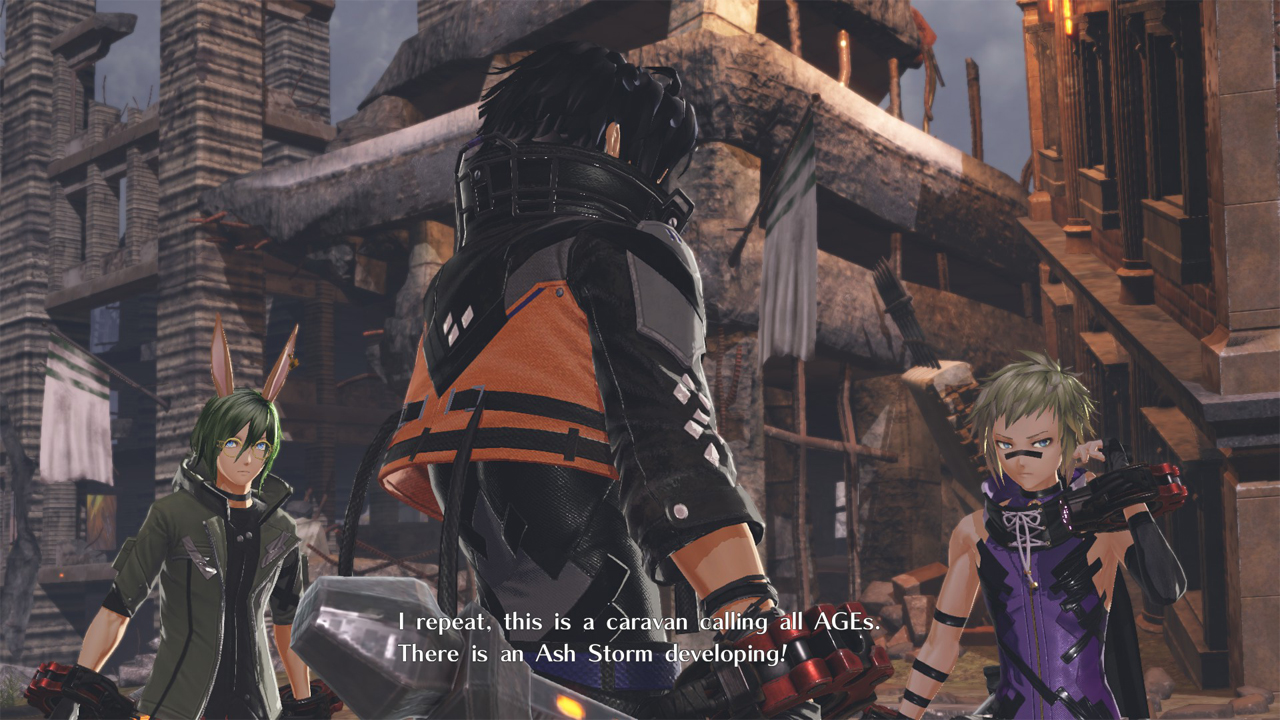
Serendipity comes when the team is sent out to quell an Ash Storm near Pennywort, one severe enough to cut off communications with base and leave them somewhat stranded. They then pick up another radio signal from a passing caravan belonging to the port Chrysanthemum and get picked up by its savvy yet kind leader Hilda, and from then on, they are bound to a new, much more favorable, employer.
How to eat the gods.
Combat has a fair amount of options to it, but is relatively simple at its core. Your two methods of aggression are light and heavy attacks, performed with the X and Y buttons respectively. Light and heavy attacks can be strung together, being interchanged freely, though the attacks won't change depending on the sequence chosen. It's a simple system, but it allows for each weapon to have a good amount of variability between attacks of different speeds and angles. A dash-dodge can be performed with the B button, with the shield deploying if holding RB as well. The dodge in God Eater 3 does not have any invincibility frames, so it's strictly used as a positioning tool to escape attacks rather than to phase through them with proper timing. Dodging does, however, allow the activation of what are called "step" attacks, which is when a light or heavy attack is used as the dodge slide is ending. These attacks usually visually carry the momentum of the slide through the attack itself, and either the step X or step Y attacks can function as the first hit in a ground combo, allowing one to immediately transfer into the second hit in an attack chain. In addition to ground-based attacks, striking while in the air allows for a variety of aerial combos of varying length (depending on the weapon equipped) which end up floating the player character somewhat until the attack string is completed, assisting in hitting flying enemies or elevated weakpoints. A shield-dash can be performed with RT+A for a large sum of stamina in order to either dash away from, or into an Aragami for some light crushing damage, and if one times their shield to deploy right as an Aragami strikes it, they'll perform a stamina-less perfect-block, which negates all chip damage. The shield dash is a solid way to gain just a bit more mobility on the field as well as extend combos, and the perfect guard is a nice reward for internalizing combat patterns. At least in theory.
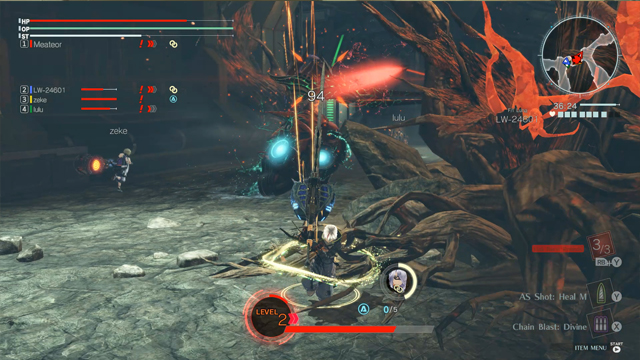
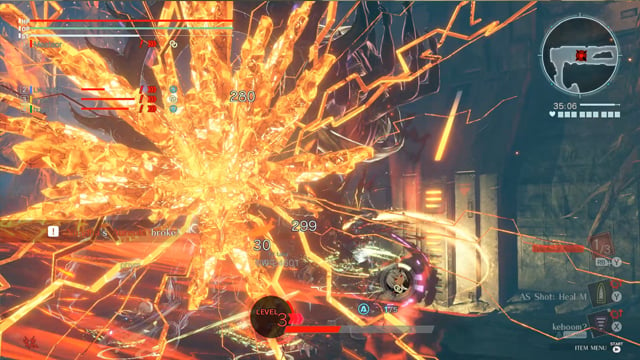
There are a variety of melee weapons to pick, all with unique movesets and different balances of damage types between slashing, piercing, and crushing. Each of those types of damage are more or less effective on specific Aragami parts, making it easier to break them, and earning the player more material rewards in the process.
- Short swords have a blend of slashing and piercing, doing the least total damage per swing but having quick and safe attacks
- Long swords are pure slash, and have a balanced attack speed/damage output
- Greatswords are slash/crushing and move slowly but hit hard
- Spears are exclusively piercing and have tricky yet flexible mobility
- Hammers are pure crush and deal high damage while being able to boost the user with a rocket affixed to the back of the weapon
- Dual blades have decent slash and pierce both with the ability to transform into a glaive form
- Scythes have pure slashing damage, the ability to reach wide areas, and increased damage the further down the weapon one strikes an enemy
- and heavy moons (a crescent-shaped weapon) are purely slashing, but have the ability to temporarily transform into an attack which deals crushing damage.
In addition to said standard attacks, your god arc can also perform what's called a "devour" attack by either charging up a slow devour by holding Y, or by pressing RB+Y for a quick chomp. Aside from the obvious catharsis associated with literally biting an Aragami in the middle of a gritty battle (it's equal parts metal and ridiculous), swallowing a hot load of oracle cells in this manner puts your character into "burst" status, powering up all attacks and, more importantly, giving access to what are called Burst Artes, attacks which replace various other actions in your arsenal. Up to three burst artes can be equipped to replace a ground attack, an aerial attack, and a step attack. Which action these artes replace is dependent both on which arte you equip to the slot as well as what variant of weapon you use. For extra flavoring, burst effects can be added to standard burst artes, which add miniscule amounts of extra damage (in slashing, piercing, or crushing) to the end of a burst arte every time it's performed. Each of these effects always append the burst artes to which they're set, but they all have unique hitboxes, visual effects, and attack speeds. Because these burst artes are largely quite a bit more powerful than standard attacks, the meta is to get into burst, stay in burst, and execute as many BAs as one can, which is much easier than one would think.
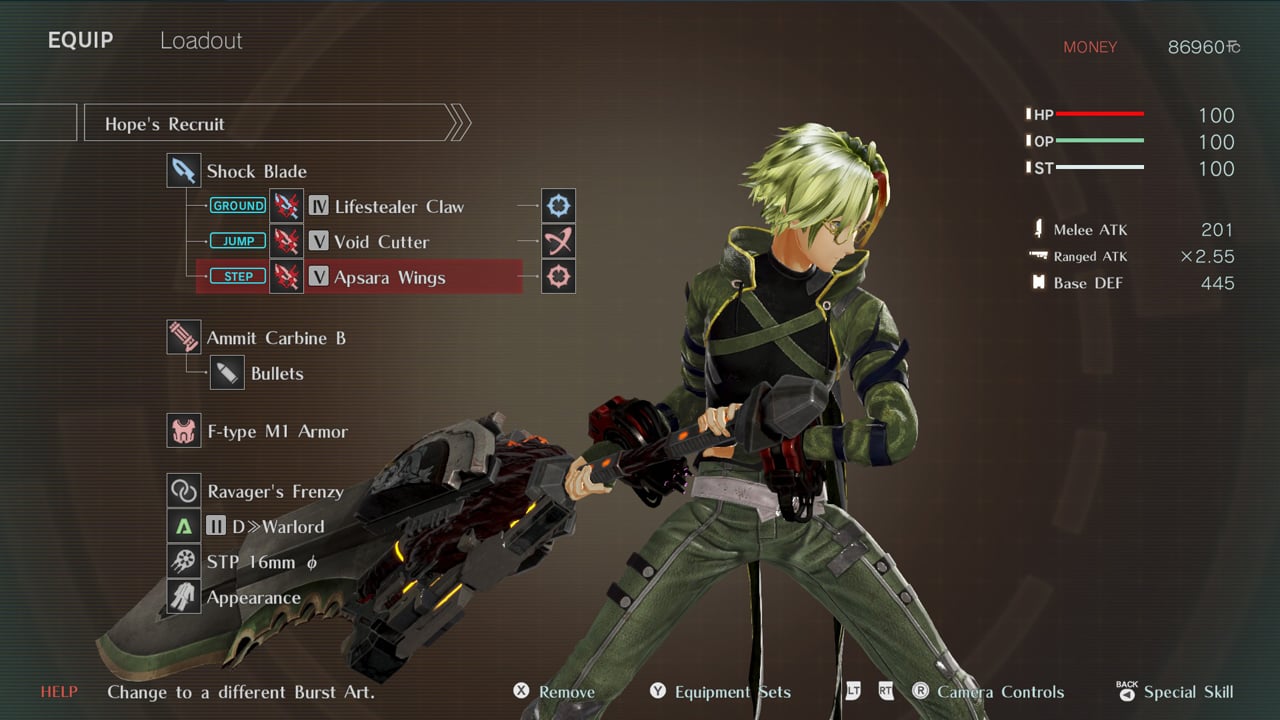
Munching an Aragami will always put the muncher into a level 1 burst, as well as refill a portion of the burst gauge, but it also grants what is called an Aragami Bullet. In the previous titles, this manifested as both a projectile you could fire back, mimicking both the attacks pattern and element of the Aragami devoured, but also as a method of putting an ally into a higher level of burst (up to level 3) by firing the bullet at them using RB+Y. This allowed for a small strategy of biting off pieces of, say, a flame Aragami, to then be fired back at a frost Aragami in the same hunt to hit its weakness. In God Eater 3, however, the only options one gets with the Aragami bullets given is to transfer them to a teammate, removing a small facet of strategy from the equation.
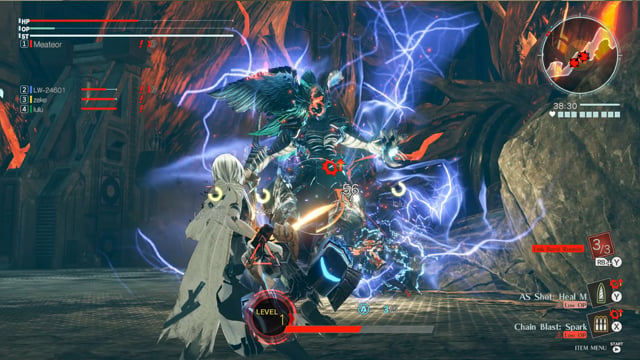
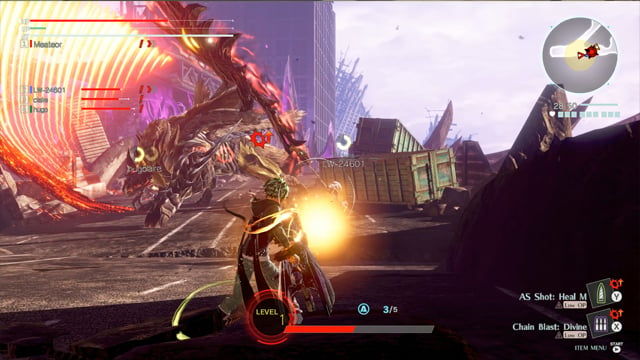
Aragami pieces aren't the only means of ranged attacks, however, as the gun/bullet systems of games prior make their return, though with some heavy changes. Similar to the multiple weapon types having their own properties and damage types, the guns sport their own spreads of qualities and damage ratios. Pressing RB briefly will switch from melee to gun mode, allowing one's oracle cells (represented by a green gauge below the health bar) to be converted into bullets and be fired at Aragami by using either the X or Y buttons (depending on which slot a particular bullet is set to). There are 4 types of guns:
- Snipers, with high piercing and a slow rate of fire
- Assault guns, with mainly piercing, a smattering of crushing, and a very quick rate of fire
- Shotguns, which have a modest firing rate, some piercing, and a tasty amount of crushing
- and gatling lasers, which function a bit differently. These allow for the storing of oracle cells via RB+B in gun mode, and when fired, are capable of emitting a constant barrage of laser, a functional stream of beam, which increases in power over time and doesn't cease until it's either shut off manually or a dodge is performed.
Returning with the guns are the customizeable bullets of old, but unfortunately, these end up taking a major backseat in GE3. The previous systems were rather involved, with many little tricks, exploits, and mathematical loopholes you could gradually wiggle your way through to maximize damage/cost, but the general idea was this: bullet pieces known as "modules" can be installed, linked to one another, and adjusted in various ways in order to program a series of strikes into a single shot. There exist the very straightforward modules, like horizontally-travelling bullets which deliver piercing damage on contact, but there are also some quirky variants, like a module that's a point-blank explosion, a circularly rotating laser, an arcing shot affected by gravity, a stationary orb which rotates at various speeds, etc. An easy-bake combo has always been using a small bullet to begin, then linking a crushing explosion to spawn upon contact with the enemy, thus delivering ranged crushing damage. It's not just on-contact that modules can spawn, either, as one can set progressive timers for modules to activate along a bullet's path, shooting lasers, explosions, or other bullets in sequence as the host bullet travels down its path. There were a number of rules governing how oracle consumption and iterative damage were calculated depending on how and when modules were spawned, but it was an engaging system because it was both complex and easily accessible; bullets able to be tested for net damage output at any and every stage of their construction.
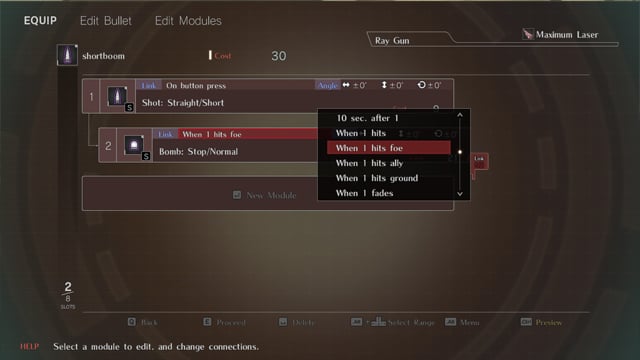
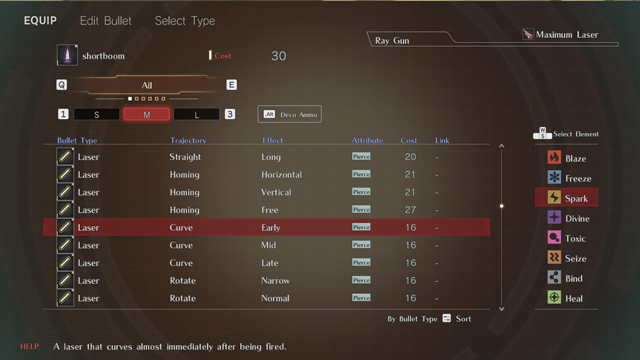
While these mechanics return seemingly wholesale for the bullet builder of God Eater 3, their usefulness has been stripped down to a mere novelty, rather than a fundamental tool. Where custom bullets previously drew from one's oracle cell gauge, something that is replenished with every physical strike that connects with an Aragami (corpse or alive), these new custom bullets are regulated to their own, static pool of ammunition which cannot be refilled through any means from the beginning of the mission to the end. The "cost" of these bullets now represents the limit of how many you can bring with you on a mission at once. The only bullets which draw from your oracle reserves, and as a result the main bullets you'll be using on a hunt, need to be bought from a store. These bullets cannot be modified, and are constructed of some of the more basic "easy-bake combos" like the one I mentioned previously.
This change affects the meta of gameplay in two critical ways. Firstly, because the bullets cannot be refilled, unloading them all blindly onto an enemy Aragami at the very start of a hunt yields almost identical results to rationing them out across the battle. Since your bullet total is a constant, it essentially represents one quantized chunk of damage that you have at your disposal, meaning any bullets left on the table after a hunt concludes amount to nothing but wasted damage. Secondly, whatever cost-effectiveness edge you can learn to scrape out of these bullets is greatly mitigated in the long run compared to previous entries just by way of how little you'll be using them compared to the normal stock bullets. This reduces the need to really learn the ins and outs of the bullet system, as benefits are drawn short, but an even larger aspect of the game which sucks min/maxing motivation is that...
This game will NEVER let you lose anything.
Yes, all these elements of combat look as though they'd come together to form something at least moderately compelling, but I'm afraid the final shot in the head for this game is its lack of challenge. Hunts will rarely go over 4 minutes long, with the average TTK being somewhere around 3.5 minutes to complete, and Aragami function less like daunting foes and more like material pinatas. A low difficulty ceiling isn't always so detrimental to the fundamental experience of a game, but in this specific case, it ends up stripping the game of just about every ounce of potential complexity the game could give.
In God Eater the first, the goal wasn't simply to survive the assault and down the Aragami, it was to be precise enough and knowledgeable enough about the Aragami's breakable spots to be able to unbind them before the foe fell, netting the best rewards. This encouraged the use of different weapon types, as many Aragami parts were only weak to a single type of attack, and bringing a loadout filled with the wrong types of damage could make breaking all parts nigh impossible. In order to reap the best rewards at the quickest pace, the player needed to not only familiarize themselves with all (or at least a decent slew of) weapon types, but also where each variant of Aragami could be broken and how, customizing bullets to exploit those areas.
Aside from the loadout aspect, it also fell heavily on mid-battle performance to properly break all bonds. Familiarity with your weapon's attack patterns was highly useful, as damage would only count on the first Aragami part struck in an arcing attack. In many cases, one would need to "thread the needle" in terms of being able to access a weak spot, and positioning, mid-combo angle adjustment, and clever bullet all were useful to this end.
In God Eater 3, there is no longer a question of "if" you will break the bonds, only "when", as Aragami seem almost poised to explode at first touch to an absurd, almost comical degree. It no longer matters what you fight, how you fight it, or what you fight it with, or even where you hit it; Aragami bonds breaking are now more indicative of its remaining health than tactics and careful play. Combined with the fact that any Aragami will fall in under 5 minutes, this means that, while the player has many burst artes at their disposal, a litany of different possible bullets to customize, and a wealth of burst arte effects to attach, none of them make any significant difference in terms of player decision-making or engagement. The short engagement time also means that there's no need to internalize the Aragami's attack patterns in the least, as the battle is over almost as soon as it began.
Playing cleanly and cleverly will result in nearly the exact same results as glazing your eyes over and mashing buttons subconsciously. Smacking blindly with whatever burst arte you want will always result in all parts breaking, firing haphazardly with no recollection of weakpoints will kill quickly, and paying no mind to incoming attacks will still net you a SSS ranking, the highest possible ranking. In fact, until rank 6, I had stopped upgrading my equipment beyond rank 3, making me very underpowered in terms of both offense and defense alike, and the game still refused to give me any less than the perfunctory SSS. Every possible instance of salient decision-making this combination of combat mechanics could have afforded means naught in either the short or long term, as the game will never directly reward you for it or punish you for not learning it. Any complexity you choose to engage in mid-combat is purely for show and style; just a means to keep the boredom from overtaking you completely. Aragami also seem to not scale in health or damage when playing in multiplayer either, exacerbating the problems if playing with friends. Perhaps the game doesn't want you to play multiplayer, however, as the damn thing launched with pointless region locking, requiring players to switch to the same download region to be able to play together.
In fact, while my friend and I played and rapidly had our enthusiasm drained, the most exciting moments of the game for the both of us became trying to find the new location of an adorable cat named "Sleepy Paws." This furtive feline appeared to never wake and never move to all aboard the caravan, but after each story mission, the cat will have changed locations. Finding it again would sometimes yield a new line of humorous flavor text as well, which was a treat.
Now you may be thinking "What's the purpose of having this here? This is irrelevant.", and under normal circumstances I'd agree, however, (aside from the fact that I promised I'd be mentioning Sleepy Paws in the review because just look at him he is precious) the humdrum act of simply finding this slumbering cat was genuinely more compelling for the both of us than engaging in any actual combat, supposedly the game's main focus.
What I also consider a fair indicator of just how undercooked this game feels, is the shoddy state of the lock-on camera. When targeting an Aragami, the camera will outright refuse to rotate horizontally to follow the enemy's movements until the lock-on indicator (positioned directly on an Aragami's center) reaches the very edge of the screen. What often happens is that an Aragami will position itself so that it's halfway off the side of your screen, yet the camera won't turn to face it because the lock-on indicator isn't far enough from your screen's center. Since being locked-on completely disables horizontal right stick adjustment of the camera, one needs to unlock, re-center the camera to the position you'd like with the right stick (or tap LB to center it behind the player), then re lock-on, all mid-combat.
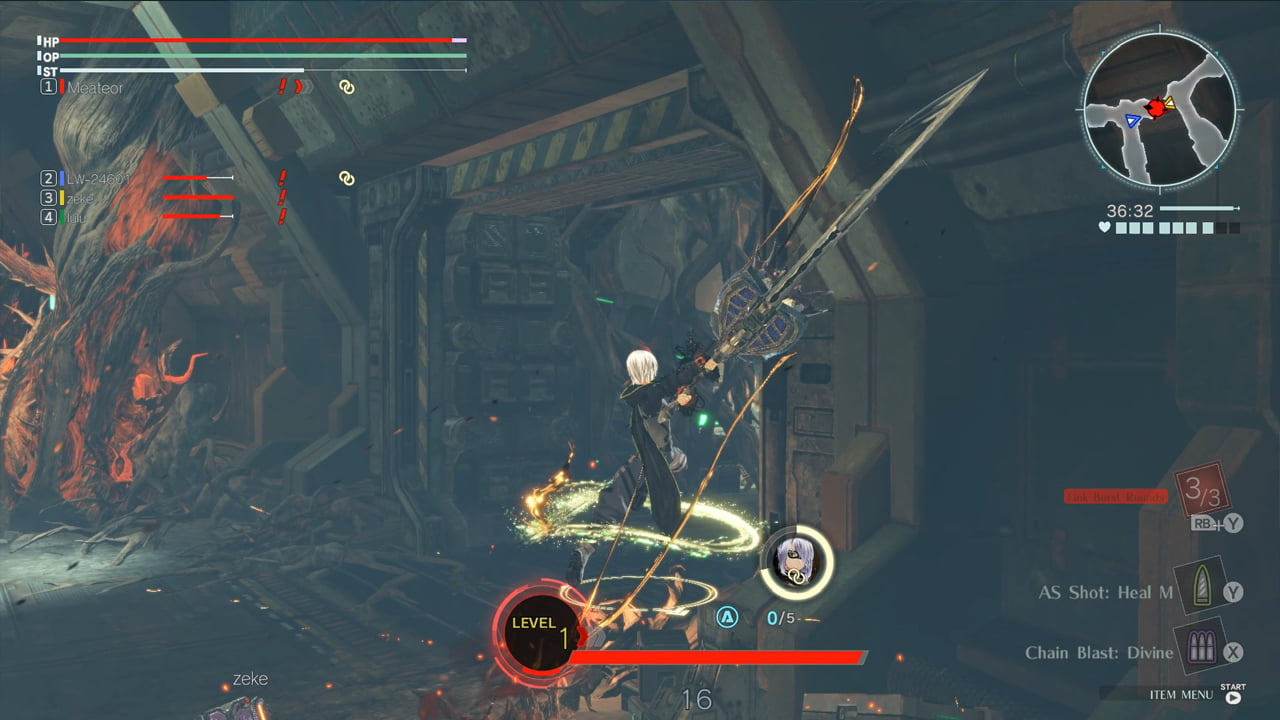
(If you look closely, you'll see the Aragami has slipped off the bottom of the screen, despite being locked on)
What this also means is that, if an Aragami moves itself behind your current camera position while locked on, the camera goes from not adjusting itself at all while it's still on screen, to WILDLY repositioning itself the second the Aragami moves off screen, making for many instances of pointless disorientation. Conversely to how it handles horizontal movement, the camera will never track an Aragami vertically, meaning that whenever the player jumps up to perform an aerial combo, they'll be left staring off into the horizon while the Aragami does its business halfway off the bottom of the screen. In the course of writing this review, I briefly played through the tutorial missions of God Eater 2: Rage Burst, and the camera there not only tracks vertically, but is generally better than GE3's by quite a large margin.
Anemic to the bone.
It isn't just the combat mechanics that are hollow, the game's content on the whole feels terribly anemic and blasé. The Aragami variety both is literally low and made to feel artificially low by means of the way they behave, with GE3 having a relatively small amount of new monsters (a list padded with elemental variants of said new monsters) and cutting out every unique fight from the previous God Eater games. Ouroboros? Arda Nova? Just about anything with unique patterns of attack has been cut from the roster. Because all the Aragami kept for GE3 take very similar strategies to defeat in previous games, now accentuated by the fact that this game now allows for a "one-size-kills-all" approach to combat, the monster lineup feels more sparse than ever. To be entirely fair, previous titles also padded their rosters with elemental variants of regular Aragami, however they not only had more unique enemies to pick up the slack, but the variants had both new attack patterns as well as adjusted locations of breakable parts. Elemental variants of GE3 largely have identical forms of attack and movement, and the adjusted hitzone values on parts make no functional difference in how one engages the monster, as breaking them will inevitably happen even if you were to consciously try and avoid it.
Story, characters, and presentation.
This third installment is the first of the franchise to solely launch on current gen home consoles as well as PC, and it really shows. Even God Eater 2 was also build for the PSP of all things, so the difference in visual fidelity between these two games is night and day, and it really looks quite nice. Character models are nicely detailed, textures look great, the lighting is well implemented to give that relatively high-contrast, anime-grit tone. Environments and Aragami get a bump in polygons as well, though the maps themselves have the same bland layout of God Eater 1, maybe even less interactive. Character designs are as appealing as ever, and while it's clear they've drawn from design archetypes they've used in previous games for many of their characters, the new designs are still fresh enough to stand on their own.
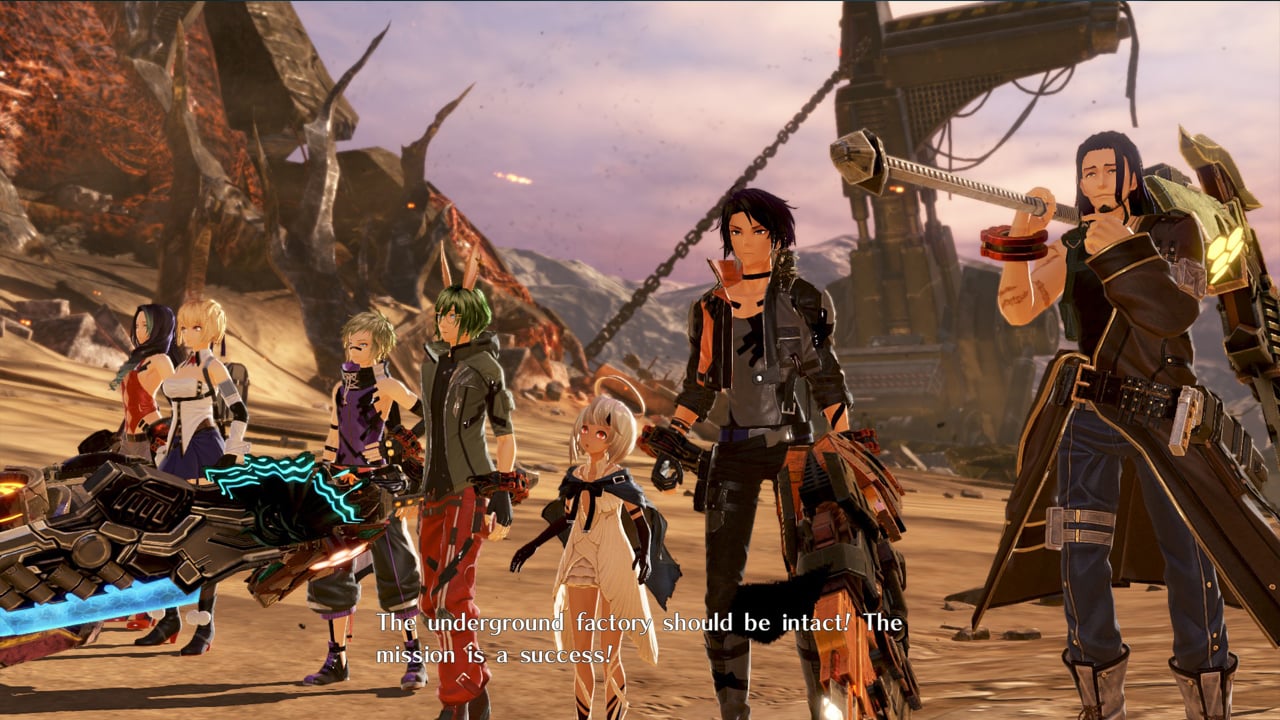
In terms of the character writing itself, I was unfortunately quite let down. Coming from the likeability and believeability of GE1's cast, the character writing of GE3 couldn't compare. The cast is decently likeable, yes, and they do have their fair share of genuinely memorable bits of flavor text as you speak with them between missions, but none of them are as deeply explored psychologically as characters like Alisa and Kota from GE1, and none reach Lindow's sheer force of charisma. Overall, the characters themselves don't tent to elevate beyond "serviceable", with one exception...
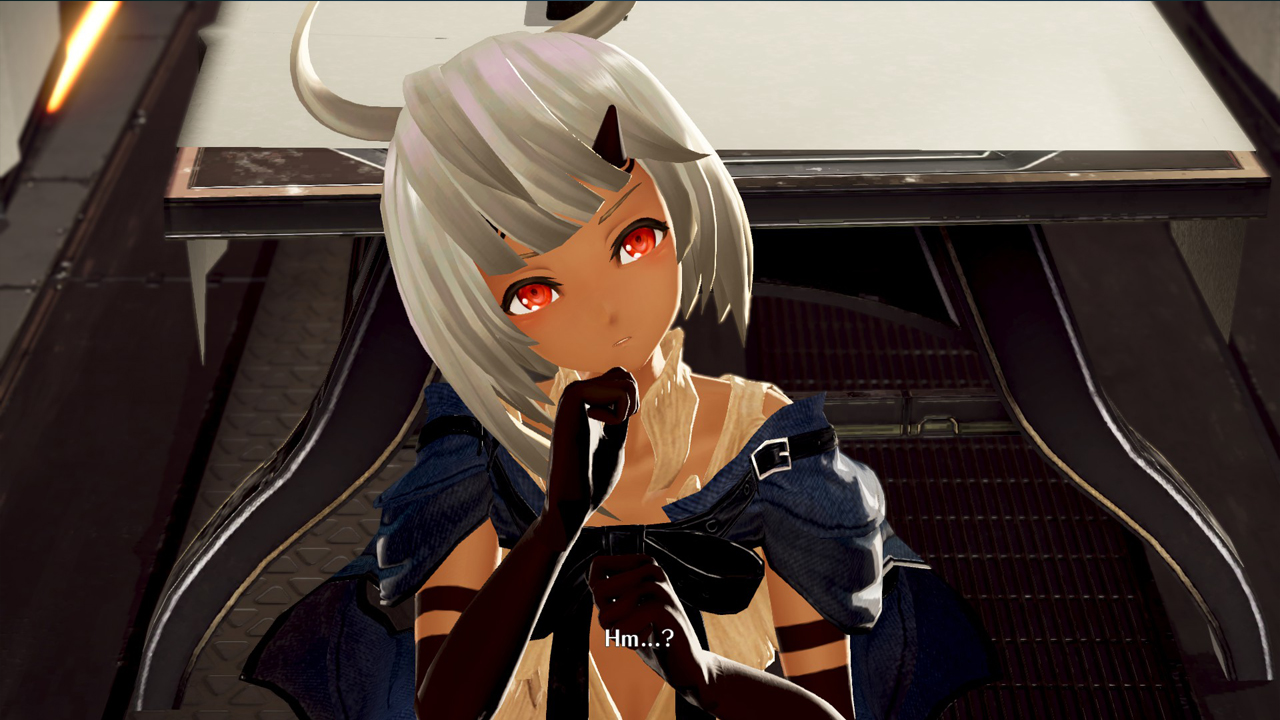
Phym is the name of a small, humanoid Aragami who joins the cast fairly early on. She takes on the appearance of a small girl, is innocent, cheerful, and able to quickly adapt to wielding a god arc in order to fight on you team, so she was immediately triggering memories of Shio from GE1. The concept and application of this character are almost 1:1 recreations of Shio's dynamic in the first title, and while Phym is probably the most blatant example of a re-used character trope, I can't deny that she grew on me to the point where she is de-facto my most adored cast member of this game. Phym is completely endearing, following the player around after coincidentally imprinting on them, and calling the player mommy/daddy. She's excessively genuine, thoughtful, vulnerable, eager for praise, selfless, and while she's not exactly an original concept, much less for this series, she was genuinely effective at eliciting a pseudo-parental desire to protect her, with her affection and innocence. She has a few lines she says where I could swear I felt my heart dripping out of my ribcage, she's so painfully precious. Not a fundamentally complex character, but she does an amazing job at pulling at those heartstrings.
Unfortunately the story itself is mostly quite boring and forgettable. Avoiding spoilers, the first half of the story has few stakes and little in the way of salient character development, and while the stakes do get quite raised by the mid-late game, things end up resolved about as soon as they began. While the story introduces themes of human rights and does slightly explore some quid-pro-quo dynamics between factions, things mostly fell quite flat. Whether or not the disengagement I was feeling because of the gameplay factored at all into that feeling, I cannot say. Many characters feel as though they're not given the proper room to be truly known or tested, though each proceeds to go through visible changes throughout the story, even if quite slight. I can recall an intended twist which fell flat, and a villain the audience was clearly meant to sympathize with to some degree despite the plot never exploring him sufficiently, but most things ended up serving as nothing but setdressing to the same Aragami fights since the beginning of the game. Nothing made me groan, but neither was I anywhere near the edge of my seat throughout.
Technicals and performance.
The game seems to run well on its own, and while I regularly experienced momentary hitching which would drop the framerate to 48 for an instant (only during cutscenes), my co-op partner didn't experience any. Otherwise the game easily maintains a solid 60fps at all times during gameplay, but this is one of the few titles I think is held back by a 60fps cap. Like just about every Bandai Namco game, God Eater 3 does not support an uncapped framerate, and at the speeds at which combat can end up moving (especially with a janky camera), the gaps between frames become more noticeable than ever. My co-op partner actually began to get a headache from the framerate, despite it being 60fps, and while I never reached the point of physical pain, I definitely needed to defocus and readjust my eyes on several occasions.
Final thoughts.
Even with a friend to laugh through it, God Eater 3 was a genuine slog to play through, despite it only lasting 30 hours. It uses mechanics from previous titles in the franchise, but not only does little to evolve them in meaningful ways to the core gameplay (sometimes stripping them clean out), but it also failed to understand how to design challenges properly to give those core mechanics utility in the first place. As of now, what I played was a hollow, empty experience of a game; something for which I could glaze my eyes over and still be showered in a burst of confetti and SSS rankings at the end. If this game ever gets a "Rage Burst" edition adding new content, it'll at best be the way the game should have launched in the first place. Traditionally, though, those expanded versions are the only versions we in the west would get. With Code Vein continuing to be developed by this same team, as it has seemingly been throughout GE3's development, I don't anticipate an extended version ever coming for it. There are many titles of this nature which execute this formula better, so I really can't recommend this game as it is right now. It's not broken, it does technically function well, it's just absolutely, painfully, mind-numbingly, boring.
Verdict
- Phym
- Sleepy Paws
- um...Sleepy Paws again
- Solid music from Go Shiina
- Vapid, hollow combat
- Complete and utter lack of challenge
- Pared back bullet customization mechanic
- No unlocked framerate
- Shonky camera
- Multiplayer region locking
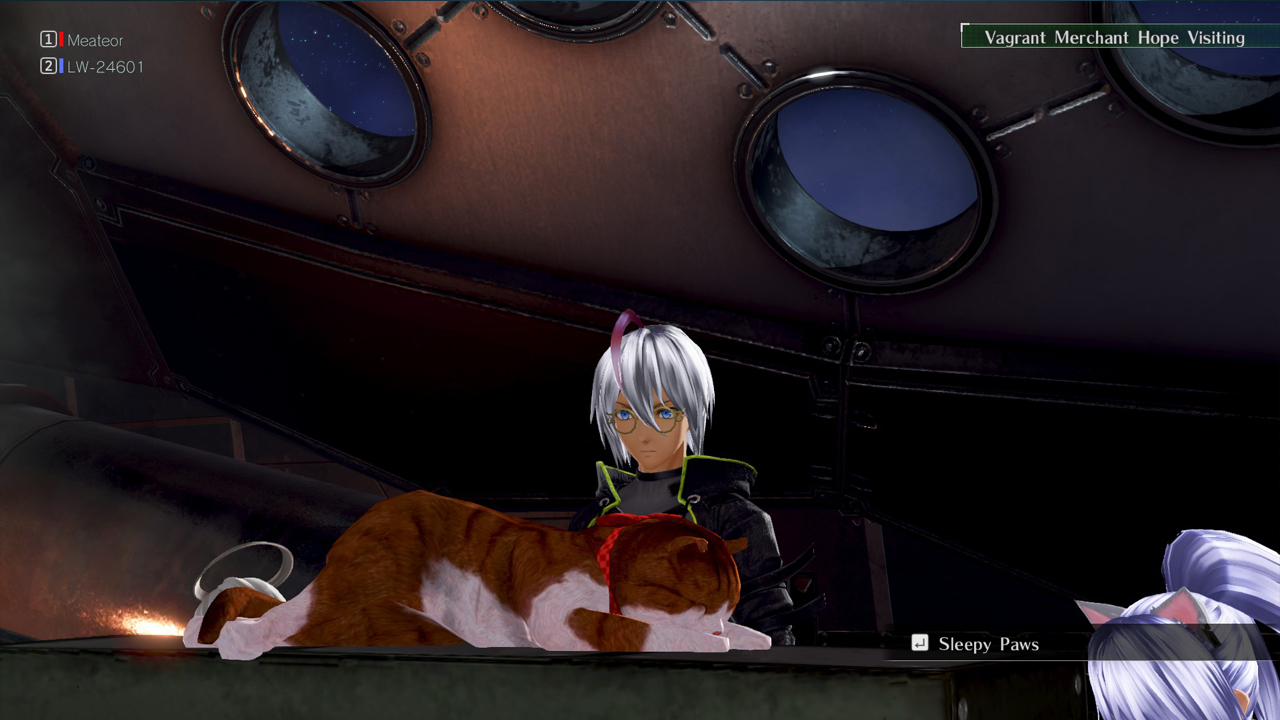



Options
View top chatters